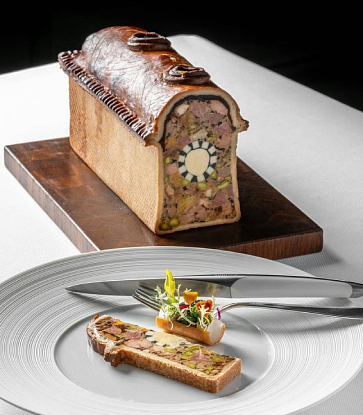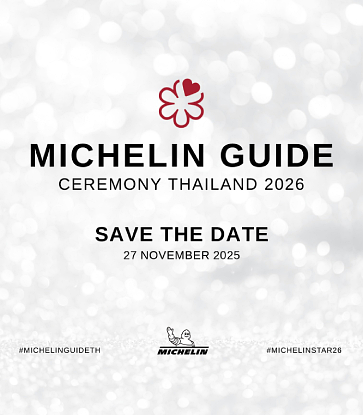When people discuss Songkran destinations, Northern provinces, especially Chaing Mai, will constantly come up. The region’s rich culture and stunning nature attract both domestic and international travellers. In addition to cooling off from the heat with water splashing, there are countless activities to enjoy. It’s also a great opportunity for a foodie to taste the authentic Northern cuisine.
Unsure which menus to order? MICHELIN Guide presents the 11 Northern Thai dishes you can’t miss.
Let’s make your Songkran trip to the North the most memorable.

Must-Try Dishes
Nam Prik Num – Nam Prik Ong – Sai Oua
Nam Prik Num is Lanna’s traditional chili dip made from young spur chilli. It’s as popular as Nam Prik Ong, another spicy dip made from pork and tomato. Any Nam Prik with Sai Oua (Local sausage stuffed with minced pork, dried chili, and various herbs such as galangal, turmeric, kaffir lime leaves, and shallots) are a pair made in gastronomic heaven. You can triple the tastiness by adding pork rind. Sai Oua and Northern pork rind are also Chaing Mai’s popular souvenirs that will impress anyone back home.Naturally, every Chiang Mai restaurant featured in MICHELIN Guide serves these must-try dishes. Some offer them in an assortment. But you can always order them separately to fully enjoy all three.
Try here:
- Krua Phech Doi Ngam
- Huen Muan Jai
- Huan Soontaree

Khai Pam
In the northern dialect, Pam (pronounced like palm without the 'L') is a grilled dish. This local specialty consists of grilled egg (Khai) wrapped in banana leaves. Chopped spring onions, chili, lemongrass, and garlic are added to enhance the flavors. Get creative by choosing additional proteins such as pork, fish, squid, or even crab sticks to make your Khai Pam unique.Try here:
- Kiti Panit
- Han Thueng Chiang Mai
- Chum (Saraphi)

Khao Soi
Khao Soi took the world by storm when it was ranked as the world’s best soup. This Chin Haw rice noodle in curry is highly popular in Northern Thailand. Ching Mai is brimming with Khao Soi joint serving variations such as beef or chicken. Khao Soi is not complete without sides of shallots and pickled cabbage. Herbs give the curry a pleasing aroma while coconut milk balances the soup’s taste. Squeeze some lime in to make it more refreshing. If you want more heat, add ground and dried chilli. They also make your Khao Soi more aromatic.Try here:
- Khao Soi Mae Manee
- Khao Soi Mae Sai
- Khao Soi Lung Prakit Kad Kom

Jor Pak Gad
Jor Pak Gad is made by boiling flowering pak choi (Pak Gad Jon) with salt and shrimp paste or fermented fish. Add tamarind sauce for extra flavour and pork ribs for protein. Some recipes call for sugarcane juice and disks of dried rotten beans called Thua Nao Khaep. The dish is aromatic with a hint of sourness. Sprinkle it with some dried chilli and fried garlic, and you’ll gulp the whole bowl in no time. Jor Pak Gad is another local dish every restaurant in Chiang Mai offers.Try here:
- Huen Muan Jai
- Kinlum Kindee
- Lumdee Te Khuadang

Khanom Chin Nam Ngiaw
Khanom Chin is a ubiquitous rice noodle dish with regional variations. (Get To Know How Khanom Chin Conquered Thailand) For Northern Thailand, it’s Khanom Chin Nam Ngiaw that’s based on Tai Yai culture. The curry is made by cooking tomato and rotten beans in pork bone broth. Some add pork ribs, minced pork, and pork blood. The most important ingredient is cotton tree flowers. Northern people consume their Khanom Chin with sides such as bean sprouts, pickled vegetables, cabbage, and sliced yardlong beans. You can add pork rinds for more texture. Khanom Chin Nam Ngiaw is always available at Khanom Chin joints across the North.Try here:
- Sanpakoi Kanomjeen
- Khao Soi Mae Sai
- Krua Phech Doi Ngam

Larb Nuea
This spicy meat salad of the North has different tastes and ingredients than its Isan counterpart. The uniqueness of Larb Nuea (or Lab Nuea) is the use of local herbs such as galangal and prickly ash seeds to diminish the meat odour while adding aroma. You can add pork blood and stir-fry the ingredients to make your Larb Nuea more flavourful. Sprinkle some fried shallots and garlic and eat with the sides of local vegetables. Larb Nuea is another must-try dish when you are in Chiang Mai. The city offers countless local cuisine and Larb restaurants.Try here:
- Han Thueng Chiang Mai
- Krua Lawng Khao
- Chum (Saraphi)

Kaeng Hang Le
Kaeng Hang Le, or Hin Le, originates from Myanmar. Its long border with Northern Thailand makes the curry popular amongst the neighbouring provinces. The curry’s main ingredient is Hin Le powder or masala spice mix. Add flavours with ginger, tamarind sauce, pickled garlic, peanuts, cane sugar, krill paste, and curry paste. The Chiang Saen-style Hang Le can contain additional ingredients. The curry traditionally uses quality pork belly and neck. Kaeng Hang Le provides complex dimensions of taste. You can feel the sourness and saltiness, with a hint of heat. The amount of curry is not overwhelming. If done properly, the balanced taste is heavenly.Try here:
- Khao
- Na Chantra
- Busarin Cuisine

Pu Ong
Pu Ong, also known as Ong Pu, is a traditional Northern dish made from the fat of ricefield crabs mixed with eggs, salt, or soy sauce. Some recipes include garlic, pepper, or sliced spring onion for added aroma. The mixture is stuffed into shells before grilling. Ricefield crabs harvested between October and December are preferred because they are higher in fat content. The creamy texture and smoky aroma of Ong Pu are beautifully complemented by sticky rice. Many restaurants in Chiang Mai featured in the MICHELIN Guide serve this delicacy.Try here:
- Kinlum Kindee
- Krua Phech Doi Ngam
- Han Thueng Chiang Mai

Tam Khanun
Tam Khanun, or Tam Ba Nun, has been Northern Thai’s staple food for a long time. The dish is made by boiling and pounding young jackfruit before stir-frying it with minced pork (not required), tomatoes, and curry paste made from herbs, shrimp paste, or rotten beans. Some recipes add fermented fish. Lightly acerbic from the young jackfruit, the dish gains dimensions of tastes, textures, and aroma with sliced kaffir lime leaves, coriander, fried garlic as well as pork rinds, deep-fried kaffir lime leaves, and deep-fried chilli on top. In addition to being a healthy dish with medicinal benefits, Tam Khanun is believed to bring good fortune.Try here:
- Lumdee Te Khuadang
- Huan Soontaree
- Han Thueng Chiang Mai

Kai Thod Makwaen
Prickly ash seeds (Makwaen) are at the heart of several Northern dishes and ingredients, including Larb and dipping. The aptly praised king of Northern Thai spice provides Northern food unique taste and aroma. Deep-fried prickly ash-marinated chicken is another delicious result. Eaten with warm sticky rice, you’ll never forget your first bite of freshly cooked pieces.Try here:
- Kiti Panit

Kaeng Khanun
A warm and hearty Lanna delicacy. Kaeng Khanun or Kaeng Ba Nun is another well-known curry made from young jackfruit, baby back ribs, climbing wattle, and wild betel. Add tomatoes for a refreshing taste. Kaeng Khanun is believed to bring auspice. The word ‘Nun’ alone can mean getting supported. So someone will always be there for you. This curry is usually prepared for special occasions such as traditional New Year or weddings.Try here:
- Kinlum Kindee
- Lumdee Te Khuadang
- Han Thueng Chiang Mai

Planning your Chiang Mai Trip
Now that you know what to eat, it's time to plan your trip. Join in the traditional New Year celebrations between 13-15 April. Have fun splashing water to cool off during the peak of summer. People from around Chiang Mai gather at important landmarks like Tha Phae Gate and Chiang Mai City Moat for lively activities. Enjoy parades, performances, and temple decorations while immersing yourself in the unique culture of Northern Thailand. And of course, don’t forget to refuel at these restaurants recommended by the MICHELIN Guide.For updates on travel destinations, contact TAT Call Center 1672, or Facebook TAT Contact Center.
Illustration image: © Shutterstock




















